| Dear Salon guests, The 'quality' of the silk and the way it reflects
light,not only its color, is a primary indication of the age of Central
Asian embroidery. There is a great difference in look between batch dyed
silks, according to legend made by families of Jewish dyers [that by the
way is what my family name means] and commercially dyed silks. One of the
pieces in the salon is late, probobly turn of the century or first quarter
20th cent. . . I'll tell which one tomorrow. . .but even from the images
posted this is to be seen from the color and look of the silk. . . .I
asked to put in the two close ups to try to give an idea of the quality
-color and lumenescence -of the dying [and the embroiery]. As to age and
location, there is palettes of colors which helps the initial gestalt as
to the age or group of the textiles . . .that is why I said Ottoman to the
textile in part two and not Mughal. About dating . . .The Russian
occupation in the second half of the 19th century and more crucially the
enforced changes of life style in the Soviet era quickly changed the style
of life that allowed these wonderful embroideries. One can see the change
in pieces from the same town that might be just 2 or 3 generations apart.
If anybody wants I have a 20th century embroidery from Shakreizebs,
[everybody spells the names in differnt ways so I might have added a new
variant now] the town where the damaged embroidery of the group of 4 in
the begining of the salon is probobly from. You can see the same flowers
but a sad and sorry reduction in detail, free flow, design, fantasy and of
course material . . .the colors are synthetic and dull and the ground
cloth, called "karbos" is machine made. I'll try to get an image made.
There are unbleached Karbos cloths to be found in early suzanis which are
brownish or tan or even with a very slight red tint . . .but yes unwashed
suzanies are filthy and stink of generation of cigarette smoke . . .I've
washed a few in my time. The early Kardos cloths have a different 'handle'
than the just-made conterfiet suzanis that appear from time to time. As to
Mr. Howe's suggestion that silk and cotton or linen are determinates of
age, this is not, from my expirience clearcut. I have seen what seems from
a design and color point of view a very early suzani on a single color
Ikat. And what seem to be early pieces on silk that was woven in
relatively narrow strips. Factory produced silk is of course a give away.
There is a group of early Lakai suzanis on silk which is falling away in
every case that I've seen which might account for the comment that really
early examples don't exit. I find the dating of carpets knotted and woven
[especially throse from perhaps 50 to 150 years ago that dealers try to
sell] to be a question of belief and interpretation, and more difficult
than dating Central Asian or Ottoman embroidery, but than I'm a textile
fan . . . bye for now Richard Farber |
 Here, thank you Mr.
Price, is the image with the unbleached karbos. Mr. Keers, thanks for the
obvious observation that I missed. These pieces do not have columns as one
see on some knoted carpets and kilims. I have seen Reshti pieces -felt and
aplications textiles - attributed to the Persian Caspian area- with
portrayed columns. . . . But then there are many archetectural niches
without columns. Columns seem to denote arches, selfstanding arches and
not niches. When do columns appear in knoted niche forms? Thanks Richard
Farber
Here, thank you Mr.
Price, is the image with the unbleached karbos. Mr. Keers, thanks for the
obvious observation that I missed. These pieces do not have columns as one
see on some knoted carpets and kilims. I have seen Reshti pieces -felt and
aplications textiles - attributed to the Persian Caspian area- with
portrayed columns. . . . But then there are many archetectural niches
without columns. Columns seem to denote arches, selfstanding arches and
not niches. When do columns appear in knoted niche forms? Thanks Richard
Farber